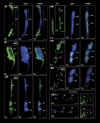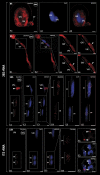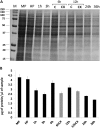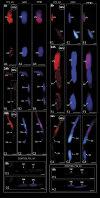Nuclear activity of sperm cells during Hyacinthus orientalis L. in vitro pollen tube growth
- PMID: 21081664
- PMCID: PMC3022407
- DOI: 10.1093/jxb/erq354
Nuclear activity of sperm cells during Hyacinthus orientalis L. in vitro pollen tube growth
Abstract
In this study, the transcriptional state and distribution of RNA polymerase II, pre-mRNA splicing machinery elements, and rRNA transcripts were investigated in the sperm cells of Hyacinthus orientalis L. during in vitro pollen tube growth. During the second pollen mitosis, no nascent transcripts were observed in the area of the dividing generative cell, whereas the splicing factors were present and their pools were divided between newly formed sperm cells. Just after their origin, the sperm cells were shown to synthesize new RNA, although at a markedly lower level than the vegetative nucleus. The occurrence of RNA synthesis was accompanied by the presence of RNA polymerase II and a rich pool of splicing machinery elements. Differences in the spatial pattern of pre-mRNA splicing factors localization reflect different levels of RNA synthesis in the vegetative nucleus and sperm nuclei. In the vegetative nucleus, they were localized homogenously, whereas in the sperm nuclei a mainly speckled pattern of small nuclear RNA with a trimethylguanosine cap (TMG snRNA) and SC35 protein distribution was observed. As pollen tube growth proceeded, inhibition of RNA synthesis in the sperm nuclei was observed, which was accompanied by a gradual elimination of the splicing factors. In addition, analysis of rRNA localization indicated that the sperm nuclei are likely to synthesize some pool of rRNA at the later steps of pollen tube. It is proposed that the described changes in the nuclear activity of H. orientalis sperm cells reflect their maturation process during pollen tube growth, and that mature sperm cells do not carry into the zygote the nascent transcripts or the splicing machinery elements.
Figures






Similar articles
-
Transcriptional activity and distribution of splicing machinery elements during Hyacinthus orientalis pollen tube growth.Protoplasma. 2008;233(1-2):129-39. doi: 10.1007/s00709-008-0298-7. Epub 2008 Jul 10. Protoplasma. 2008. PMID: 18615237
-
Distribution of poly(A) RNA and splicing machinery elements in mature Hyacinthus orientalis L. pollen grains and pollen tubes growing in vitro.Protoplasma. 2006 May;227(2-4):95-103. doi: 10.1007/s00709-005-0153-z. Epub 2006 May 30. Protoplasma. 2006. PMID: 16736251
-
Epigenetic marks in the Hyacinthus orientalis L. mature pollen grain and during in vitro pollen tube growth.Plant Reprod. 2016 Sep;29(3):251-63. doi: 10.1007/s00497-016-0289-3. Epub 2016 Jul 15. Plant Reprod. 2016. PMID: 27422435 Free PMC article.
-
Cytoplasmic connection of sperm cells to the pollen vegetative cell nucleus: potential roles of the male germ unit revisited.J Exp Bot. 2011 Mar;62(5):1621-31. doi: 10.1093/jxb/err032. J Exp Bot. 2011. PMID: 21357775 Review.
-
The regulation of vesicle trafficking by small GTPases and phospholipids during pollen tube growth.Sex Plant Reprod. 2010 Jun;23(2):87-93. doi: 10.1007/s00497-009-0118-z. Epub 2009 Nov 7. Sex Plant Reprod. 2010. PMID: 20490965 Review.
Cited by
-
Transcriptional activity of Hyacinthus orientalis L. female gametophyte cells before and after fertilization.Planta. 2012 Jul;236(1):153-69. doi: 10.1007/s00425-012-1599-9. Planta. 2012. PMID: 22293855 Free PMC article.
-
Intercellular communication in Arabidopsis thaliana pollen discovered via AHG3 transcript movement from the vegetative cell to sperm.Proc Natl Acad Sci U S A. 2015 Oct 27;112(43):13378-83. doi: 10.1073/pnas.1510854112. Epub 2015 Oct 14. Proc Natl Acad Sci U S A. 2015. PMID: 26466609 Free PMC article.
-
The male germ unit association is independently regulated of GUM in Arabidopsis thaliana.Plant Direct. 2024 Jul 29;8(7):e624. doi: 10.1002/pld3.624. eCollection 2024 Jul. Plant Direct. 2024. PMID: 39076347 Free PMC article.
-
Bioimaging insights into structural pathways of cell-to-cell communication within the male (MGU) and female (FGU) germ units of Arabidopsis thaliana.Plant Cell Rep. 2025 Feb 14;44(3):56. doi: 10.1007/s00299-025-03441-w. Plant Cell Rep. 2025. PMID: 39953194 Free PMC article.
-
Ribosomal RNA of Hyacinthus orientalis L. female gametophyte cells before and after fertilization.Planta. 2012 Jul;236(1):171-84. doi: 10.1007/s00425-012-1618-x. Epub 2012 Mar 8. Planta. 2012. PMID: 22398640 Free PMC article.
References
-
- Bayer M, Nawy T, Giglione C, Galli M, Meinnel T, Lukowitz W. Paternal control of embryonic patterning in Arabidopsis thaliana. Science. 2009;323:1485–1488. - PubMed
-
- Bentley DL. Rules of engagement: co-transcriptional recruitment of pre-mRNA processing factors. Current Opinion in Cell Biology. 2005;17:251–256. - PubMed
-
- Berger F, Hamamura Y, Ingouff M, Higashiyama T. Double fertilization—caught in the act. Trends in Plant Science. 2008;13:437–443. - PubMed
-
- Bino RJ, Van Tuyl JM, De Vries JN. Flow cytometric determination of relative nuclear DNA contents in bicellulate and tricellulate pollen. Annals of Botany. 1990;65:3–8.
Publication types
MeSH terms
Substances
LinkOut - more resources
Full Text Sources
Research Materials
Miscellaneous

